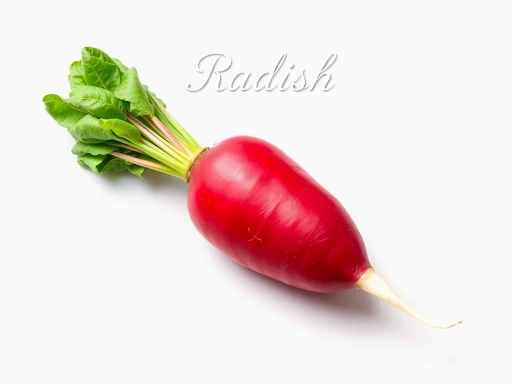Raddish: A Crop of Shifting Benefits for Climate Change, Agriculture, and Nutrition
The ecosystem balance has transformed since the introduction of raddishes. These crops were helpful to peasant farmers and today are assisting in climate adaptation. In addition to small scale farming, raddishes also help improve plants, aid in pollination and even assist in detoxification diets. This paper outlines the contributions of raddishes to climate change adaptation.
1. Raddish Agronomic Practices for Smoothly Changing Climatic Conditions
Drought-Resistant Raddish Type and Their Relative Adaptation in Dry Areas
There is a growing necessity for crops that can withstand droughts as a result of frequent temperature hikes and persistent rainfall. Due to well developed taproots, the Cherry Belle and Daikon raddish varieties can endure drought, as they can reach moisture from deep soil layers. Such varieties are suitable for dry zones and can survive with little irrigation.
Soil Erosion and Land Stability Problems Associated with Raddishes
Soil conservation includes raddish as one of the key crops. Raddish loosens the soil due to its deep roots which also helps in soil and water conservation. Farmers often grow raddishes for cover crops to enhance soil quality and reduce surface runoff and top soil loss, especially on hilly slopes and regions prone to heavy rainfall.
Raddish Cultivation in Extreme Temperatures: Cold and Heat Tolerant Cultivers
Both the Black Spanish raddish and the White Icicle raddish have a range of suitable climates. Black Spanish grows best in colder temperatures while the latter is heat tolerant. These more adaptable cultivars may increase the importance of raddishes as an economically beneficial crop in regions that undergo harsh temperature changes. As selective breedings progress through different seasons, varieties that are more capable of surviving in diverse environments are produced.
Irrigation is a Challenge to Radish Farming and Can Lead to Unexpected Benefits.
Unpredictable rain can interfere with farming techniques for raddishes. While drought leads to stunted growth, too much moisture can lead to root rot. To lowere these risks farmers have begun utilizing water saving drip systems and resting raddishes on raised beds to prevent them from sitting in water.
The Use of Raddish in Agroforestry and Climate Change Adaptive Farming Practices
Asrdadish is grown in combination with trees and other crops in agroforestry systems for biodiversity and resilience purposes. Its fast growth along with the ability to grow through compaction allows nutrients and water to be made available to other companion crops.
2. The Importance of Raddish Genetic Diversity for Plant Breeding
Wild Relatives of Cultivated Raddish and Their Noteworthy Traits
Raddishes possess wild relatives in Asia and the Mediterranean which accounts for their wide genetic diversity. These wild relatives have such attributes as disease resistance and harsh climate endurance which breeders utilize to improve modern raddish cultivars.
The Importance Of Hybrid Raddish Varieties In Commercial Crop Production
Hybrid radishes have been developed through selective breeding with greater yield potential, uniform size, and wider resistance to pest and diseases. Their uniformity make them commercially acceptable hence farmers’ preference for hybrid cultivars which invariably ensure constant supply and profit.
Methods of Improving Radish by Genetic Engineering and Conventional Crossbreeding
The use of genetic modification, even though controversial, is assistive in traditional cross breeding of radish plants.
Farmers are benefitting from improved quality radishes due to the adoption of desirable traits such as increased growth rate, better taste, and enhanced disease resistance during the breeding program.
Radish Seed Banks and Conservation Efforts to Protect Genetic Diversity
In relation to seeds, the conservation of radish biodiversity is done precisely in seed banks. Institutions attempt to save and store the seeds from specific and vintage varieties of radishes so that the genetic material can be used in agriculture in the ensuing times. These efforts contribute towards guarding some varieties of radishes against extinction and at the same time, assist in achieving food security.
Future Prospects in Radish Breeding: Flavor, Size, and Disease Resistance
The new targets for breeding radishes are their taste, commercial sized dimensions, and stronger resistance to diseases and pests. Farmers will soon be able to access newer biotechnologically designed varieties of radishes to meet the emerging needs of the market.
- Bees and the Preservation of Pollinators: Radishes and their Multifunctional Use
Radish Flower Utilization to Support Honeybee Populations
Bees and other pollinators are charmed by both the nectar and the pollen from radish flowers. For that reason, some beekeepers intercrop radish or grow it close to apiaries to enhance the nutrition available for the hives, which guarantees healthy populations of bees.
Radishes and their Role in Cover Cropping to Enhance Pollinator Diversity on Agricultural Land
Aside from honey bees, other pollinator species including some butterflies and certain native bees also benefit from radish flowers. To promote diversity, farmers use radish as a cover crop, which helps maintain ecological balance.
Evaluating Radish Within a Broader Framework of a Specific Pollinator Study Considering Nectar Production
Evidence suggests that bees have an appetite for nectar from radish flowers comparable to their appetite for the nectar from mustard and clover. Along with that, the extended blooming period of these flowers contributes to the availability of food for pollinators throughout the year.
The Benefit of Natural Pollination In Radish Farming, With Special Reference to Seed Production Yield
There’s a relationship between seed production in radish and its level of pollination. Farms with adequate numbers of pollinators per acre reported increased yields of seed, along with better quality radish, thus suggesting the need to maintain a healthy pollinator habitat.
Radish In The Urban And Wildflower Garden: A Means For Promoting Beneficial Insects
Urban gardeners cultivate radish with the purpose of providing food to pollinators like bees and butterflies as part of a green pollinator friendly space. Radish bloom helps foster urban biodiversity and aids in building insect population in cities which have limited green spaces.
4. The Role of Radish In Detox Diets And Traditional Cleansing Practices
Detoxifying Effect of Radish and its Action on Liver Functions
The cleansing ability of radish as a vegetable is multifold, especially with liver detoxification through its constituents enhancing bile stimulation which improves digestion and excretion through defecation. Hence, radish is a significant vegetable in cleansing diets.
Juicing Radishes and their Impact on Detoxification Theories of Irrelevance from the Past and Today’s Remedies
Traditional techniques, including Ayurveda and Traditional Chinese Medicine, have recommended the use of radish juice for detoxification. Today, wellness fads again encourage the intake of drinks containing radish or its derivatives for cleansing purposes.
How Radishes Help With Kidney Function and As A Homeostatic Agent
Probiotic Diets or Gastrointestinal And Metabolic Disorders With Pickled Fermented Radish
Microlactin™ in the form of pickled radish present in Korean kimchi or Japanese takuan helps maintain intestinal microflora. Foods of this nature are generally deemed as easy to digest, thus having a better chance of facilitating metabolism and improving theD-immune response.
Detoxifying With Radishes In Ayurveda and Traditional Chinese Medicine
Because of its cleansing properties, radish is included in ancient healing diets. It serves as a body heat regulator, anti-diarrhea and detox agent which can lead to overall better health.
5. The Role of Economic and Social Factors in the Operation of Radish Marketing Cooperatives and Smallholder Farming
How Radish Cooperatives Help Smallholder Farmers and Rural Development
Marketing cooperatives for radishes help smallholder farmers to consolidate. These cooperatives help smallholders to achieve economies of scale and assist in enhanced income as well as ethical marketing.
The Role of Radish Farming in the Income Earning Activities of Women and Other Minorities
Women and other marginalized people can participate in farming and make a livelihood from it, especially from growing radishes. This crop provides a good chance for economic betterment due to its low production cost.
Growers’ and Investors’ Attitudes toward Radish as a Recession Resistant Crop Among Smallholder Farmers
Radishes are in high demand and have an astounding growth cycle. The ability to grow this crop all year long makes it an excellent source of income.
The Effect of Local Consumer Culture and Farm to Table Movement on the Consumption of Radishes
People are becoming more interested in consuming radishes due to the growing appreciation of local produce. Radish producers sell to buyers directly at farmers’ markets, Community Supported Agriculture (CSAs), and restaurants that practice farm to table.
The function of the Government and Non-Governmental Organizations in the Development of Radish Farming in Developing Economies – A Case Study
There are a number of non-governmental organizations that assist in the growing of radishes through seed distribution, training, and monetary assistance. These actions tend to improve agricultural productivity and increase food availability.
Conclusion
Radishes are more than just a side salad ingredient. They can be grown in different climates, which supports sustainable agriculture. They are good for pollinators, nutritious, and economically beneficial to smallholders. Continued research and innovative approaches will ensure radish meets challenges and opportunities to aid in the global food system.
Read also: Functions of Raddish in Urban Gardening and Vertical Farming



